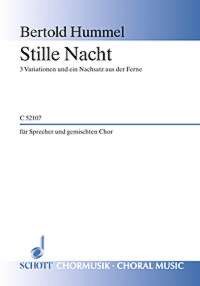Silent night, 3 Variations (in English) for Speaker and mixed Choir a cappella (1974/1980)

Variations 2 and 3  german version
german version
First
performance ot the 3 Variations:
Dezember 8, 1974, Hamburg, St. Michaelis
Elisabeth
Flickenschildt (Sprecherin), St. Michaelis-Chor, Leitung: Günter Jena
Duration:
9 minutes

Foreword
(Schott Music C 52107)
When
the newly appointed Director of Church Music, Günter Jena, inaugurated the
extremely successful concert event with music and poetry for the Advent season
in 1974 which continues to be held up to the present day in Hamburg's largest
church, St. Michael, a church steeped in tradition, he requested Bertold Hummel
to compose three variations on the universally famous Christmas carol "Stille
Nacht" ["Silent Night"] for the choir of St Michael's.
The idea
was to incorporate the Speaker who recited seasonal poetry for Advent and Christmas
between the musical works into this lied motet. For the first three performances
of this composition in the "Hamburg Michel", two of the most famous
German actors participated in this event: Elisabeth Flickenschildt (1974/1975)
and Heinz Rühmann (l 978).
Following a request by the Würzburg Cathedral
Boys' Choir, my father composed an "epilogue from afar" at short notice
for a performance of the work in the St. Kilian Cathedral in Würzburg on
26th December 1980. With this movement, he was complying with the necessity for
harmony which is most pronounced around this festive season and resolved the otherwise
ambiguous final phrase of the third verse in a radiant C-major.
Choirs who
wish to incorporate this effective composition into their Christmas repertoire
are welcome to make their own decision regarding the culmination of this work.
Martin Hummel (Translation: Lindsay Chalmers-Gerbracht)
Silent night
Silent
night, holy night!
All is calm, all is bright
Round yon virgin Mother and
Child.
Holy Infant, so tender and mild,
Sleep in heavenly peace!
Silent
night, holy night!
Son of God, love's pure light;
Radiant beams from Thy
holy face
With the dawn of redeeming grace,
|: Jesus, Lord, at Thy birth.
:|
Silent night, holy night!
Shepherds
quake at the sight.
Glories stream from heaven afar,
Heavenly hosts sing
Alleluia!
|: Christ the Savior is born. :|
In
the course of the première in 1974, Elisabeth Flickenschildt read from the
motet "Stille Nacht" ["Silent Night"] and from “Weihnacht
im Großstadtbahnhof” [“Christmas in the Big City Railway Station”] by Heinrich
Böll, followed by “Die Nacht ist vorgedrungen” [“The Night is Almost Past”] by
Jochen Klepper.
The commission for the composition was formulated by Günther Jena as follows:
Dear
Mr. Hummel,
The
song is enclosed. It must, of course, be pitched higher for the choir. As Ms.
Flickenschildt is present, the first stanza could also be set for a speaker
heard above the choir – but I do not know if this is suitable, as the story by
Böll is to be read immediately before it. The second and third verses should,
in my opinion, be interchanged in order to achieve a clearer (dynamic?)
intensification. A swelling of the number of singers can also be arranged,
there are 90 - 100 singers in the choir.
The
whole evening will accompanied by several lighting effects: it begins in an
Advent mood in the darkened church, then candles are added and, at the end of
the evening, the church is to have festive illumination amid the Christmas
jubilation. During the 3rd verse, a spotlight could focus on a
golden sun and the risen Christ in the altarpiece and thus, for the first time,
make the church noticeably brighter. Unfortunately, I have left the Böll story
at home, but you can perhaps imagine roughly what kind of atmosphere he
captures in a main station on Christmas Eve: loneliness, abandonment, darkness,
bleakness.
Yours,
Günter Jena
Press
Musica
sacra, September/Oktober 2007
Stefan Rauh
Fränkisches
Volksblatt, 29th December, 1980
Hummel’s
four to eight-part choral setting of Gruber’s world-famous melody “Silent
Night” (written for Günther Jena’s Michaelis Choir in Hamburg) works with
patterns which allow broad underlying layers of sound (with clusters and
glissandos) to emerge into vacillation and undulation. From every direction,
angel-like voices are heard as sub- and superstructures, while restrained,
dissonant conflicts raise the coherent texture above any temptation towards
cloyingness.
See also: Christmas Music by Bertold Hummel